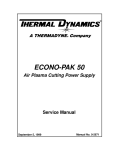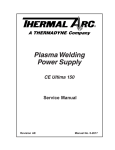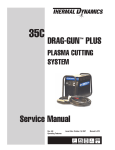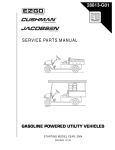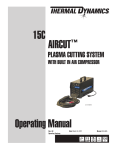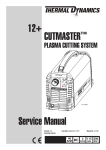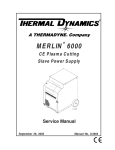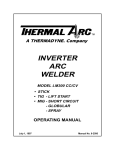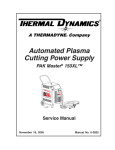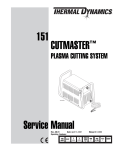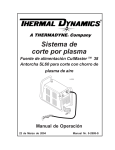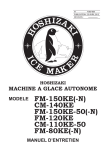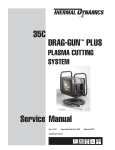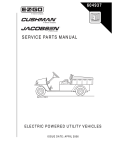Download Thermal Dynamics Drag-Gun Plasma Cutting
Transcript
Plasma Cutting Power Supply Drag-gunTM A-03642 Service Manual November 11, 2003 Manual No. 0-2683 WARNINGS Read and understand this entire Manual and your employer’s safety practices before installing, operating, or servicing the equipment. While the information contained in this Manual represents the Manufacturer's best judgement, the Manufacturer assumes no liability for its use. Plasma Cutting Power Supply with Built-in Air Drag-Gun Service Manual Number 0-2683 Published by: Thermal Dynamics Corporation 82 Benning Street West Lebanon, New Hampshire, USA 03784 (603) 298-5711 www.thermal-dynamics.com Copyright 1999 by Thermal Dynamics Corporation All rights reserved. Reproduction of this work, in whole or in part, without written permission of the publisher is prohibited. The publisher does not assume and hereby disclaims any liability to any party for any loss or damage caused by any error or omission in this Manual, whether such error results from negligence, accident, or any other cause. Printed in the United States of America Publication Date: November 11, 2003 Record the following information for Warranty purposes: Where Purchased:____________________________________ Purchase Date:_______________________________________ Power Supply Serial #:________________________________ Torch Serial #:________________________________________ TABLE OF CONTENTS SECTION 1: GENERAL INFORMATION ................................................................................................... 1 1.01 1.02 1.03 1.04 1.05 1.06 1.07 1.08 Notes, Cautions and Warnings ......................................................................... Important Safety Precautions .......................................................................... Publications ..................................................................................................... Note, Attention et Avertissement ..................................................................... Precautions De Securite Importantes .............................................................. Documents De Reference ................................................................................ Declaration of Conformity ................................................................................ Statement of Warranty ..................................................................................... 1 1 2 3 3 5 7 8 2.0 INTRODUCTION .................................................................................................................... 9 2.1 2.2 2.3 2.4 2.5 Scope Of Manual .............................................................................................. 9 General Service Philosophy .............................................................................. 9 Service Responsibilities .................................................................................... 9 Technical Specifications .................................................................................... 9 Dimensions ...................................................................................................... 10 3.0: TROUBLESHOOTING .......................................................................................................... 11 3.1 3.2 3.3 3.4 3.5 3.6 Introduction ...................................................................................................... 11 Periodic Inspection & Maintenance .................................................................. 11 Common Cutting Faults ................................................................................... 11 Common Operating Problems .......................................................................... 11 Troubleshooting Guide ...................................................................................... 12 Torch & Leads Troubleshooting ......................................................................... 15 4.0 REPLACEMENT PROCEDURES .......................................................................................... 17 4.1 4.2 4.3 4.4 4.5 4.6 4.7 4.8 4.9 4.10 4.11 4.12 4.13 4.14 4.15 4.16 General Information ........................................................................................ 17 Removing Cover/Handle ................................................................................. 17 Torch Head Assembly Replacement ............................................................... 17 Torch Switch Only Replacement ..................................................................... 19 Air Compressor Replacement ......................................................................... 19 Capacitor Replacement ................................................................................... 20 Control PC Board Replacement ...................................................................... 20 Power Relay Replacement .............................................................................. 21 ON/OFF Power Switch Replacement .............................................................. 21 Fan Replacement ............................................................................................ 22 Diode Bridge Rectifier Replacement ................................................................ 22 Transformer/Ferrite Core Assembly Replacement ........................................... 23 Input Voltage Changeover (For 208/230 VAC Service Only) ............................ 23 Torch & Leads Replacement ........................................................................... 24 Work Cable Replacement ............................................................................... 25 Primary Input Power Cable Replacement ........................................................ 25 TABLE OF CONTENTS (Continued) 5.0 PARTS LIST ......................................................................................................................... 27 5.1 5.2 5.3 5.4 5.5 Returns ............................................................................................................ 27 Parts Replacement .......................................................................................... 27 Power Supply Replacement Parts ....................................................................28 Options & Accessories (not shown) .................................................................28 Torch Replacement Parts ................................................................................. 30 APPENDIX I - INTERCONNECTING DIAGRAM ..........................................................................31 APPENDIX II - INTERCONNECTING DIAGRAM ......................................................................... 32 SECTION 1: GENERAL INFORMATION GASES AND FUMES Gases and fumes produced during the plasma cutting process can be dangerous and hazardous to your health. 1.01 Notes, Cautions and Warnings • Keep all fumes and gases from the breathing area. Keep your head out of the welding fume plume. Throughout this manual, notes, cautions, and warnings are used to highlight important information. These highlights are categorized as follows: • Use an air-supplied respirator if ventilation is not adequate to remove all fumes and gases. NOTE • The kinds of fumes and gases from the plasma arc depend on the kind of metal being used, coatings on the metal, and the different processes. You must be very careful when cutting or welding any metals which may contain one or more of the following: An operation, procedure, or background information which requires additional emphasis or is helpful in efficient operation of the system. CAUTION Antimony Arsenic Barium Beryllium Cadmium A procedure which, if not properly followed, may cause damage to the equipment. Chromium Cobalt Copper Lead Manganese Mercury Nickel Selenium Silver Vanadium • Always read the Material Safety Data Sheets (MSDS) that should be supplied with the material you are using. These MSDSs will give you the information regarding the kind and amount of fumes and gases that may be dangerous to your health. WARNING A procedure which, if not properly followed, may cause injury to the operator or others in the operating area. • For information on how to test for fumes and gases in your workplace, refer to item 1 in Subsection 1.03, Publications in this manual. 1.02 Important Safety Precautions • Use special equipment, such as water or down draft cutting tables, to capture fumes and gases. WARNINGS • Do not use the plasma torch in an area where combustible or explosive gases or materials are located. • Phosgene, a toxic gas, is generated from the vapors of chlorinated solvents and cleansers. Remove all sources of these vapors. OPERATION AND MAINTENANCE OF PLASMA ARC EQUIPMENT CAN BE DANGEROUS AND HAZARDOUS TO YOUR HEALTH. • This product, when used for welding or cutting, produces fumes or gases which contain chemicals known to the State of California to cause birth defects and, in some cases, cancer. (California Health & Safety Code Sec. 25249.5 et seq.) Plasma arc cutting produces intense electric and magnetic emissions that may interfere with the proper function of cardiac pacemakers, hearing aids, or other electronic health equipment. Persons who work near plasma arc cutting applications should consult their medical health professional and the manufacturer of the health equipment to determine whether a hazard exists. ELECTRIC SHOCK Electric Shock can injure or kill. The plasma arc process uses and produces high voltage electrical energy. This electric energy can cause severe or fatal shock to the operator or others in the workplace. To prevent possible injury, read, understand and follow all warnings, safety precautions and instructions before using the equipment. Call 1-603298-5711 or your local distributor if you have any questions. Date: November 15, 2001 • Never touch any parts that are electrically “live” or “hot.” 1 GENERAL INFORMATION • Wear dry gloves and clothing. Insulate yourself from the work piece or other parts of the welding circuit. PLASMA ARC RAYS • Repair or replace all worn or damaged parts. Plasma Arc Rays can injure your eyes and burn your skin. The plasma arc process produces very bright ultra violet and infra red light. These arc rays will damage your eyes and burn your skin if you are not properly protected. • Extra care must be taken when the workplace is moist or damp. • Install and maintain equipment according to NEC code, refer to item 9 in Subsection 1.03, Publications. • To protect your eyes, always wear a welding helmet or shield. Also always wear safety glasses with side shields, goggles or other protective eye wear. • Disconnect power source before performing any service or repairs. • Wear welding gloves and suitable clothing to protect your skin from the arc rays and sparks. • Read and follow all the instructions in the Operating Manual. • Keep helmet and safety glasses in good condition. Replace lenses when cracked, chipped or dirty. FIRE AND EXPLOSION • Protect others in the work area from the arc rays. Use protective booths, screens or shields. Fire and explosion can be caused by hot slag, sparks, or the plasma arc. • Use the shade of lens as suggested in the following per ANSI/ASC Z49.1: • Be sure there is no combustible or flammable material in the workplace. Any material that cannot be removed must be protected. • Ventilate all flammable or explosive vapors from the workplace. • Do not cut or weld on containers that may have held combustibles. Minimum Protective Shade No. Suggested Shade No. Less Than 300* 8 9 300 - 400* 9 12 400 - 800* 10 14 * These values apply where the actual arc is clearly seen. Experience has shown that lighter filters may be used when the arc is hidden by the workpiece. • Provide a fire watch when working in an area where fire hazards may exist. • Hydrogen gas may be formed and trapped under aluminum workpieces when they are cut underwater or while using a water table. DO NOT cut aluminum alloys underwater or on a water table unless the hydrogen gas can be eliminated or dissipated. Trapped hydrogen gas that is ignited will cause an explosion. 1.03 Publications Refer to the following standards or their latest revisions for more information: 1. OSHA, SAFETY AND HEALTH STANDARDS, 29CFR 1910, obtainable from the Superintendent of Documents, U.S. Government Printing Office, Washington, D.C. 20402 NOISE 2. ANSI Standard Z49.1, SAFETY IN WELDING AND CUTTING, obtainable from the American Welding Society, 550 N.W. LeJeune Rd, Miami, FL 33126 Noise can cause permanent hearing loss. Plasma arc processes can cause noise levels to exceed safe limits. You must protect your ears from loud noise to prevent permanent loss of hearing. 3. NIOSH, SAFETY AND HEALTH IN ARC WELDING AND GAS WELDING AND CUTTING, obtainable from the Superintendent of Documents, U.S. Government Printing Office, Washington, D.C. 20402 • To protect your hearing from loud noise, wear protective ear plugs and/or ear muffs. Protect others in the workplace. 4. ANSI Standard Z87.1, SAFE PRACTICES FOR OCCUPATION AND EDUCATIONAL EYE AND FACE PROTECTION, obtainable from American National Standards Institute, 1430 Broadway, New York, NY 10018 • Noise levels should be measured to be sure the decibels (sound) do not exceed safe levels. • For information on how to test for noise, see item 1 in Subsection 1.03, Publications, in this manual. GENERAL INFORMATION Arc Current 5. ANSI Standard Z41.1, STANDARD FOR MEN’S SAFETY-TOE FOOTWEAR, obtainable from the American National Standards Institute, 1430 Broadway, New York, NY 10018 2 Date: November 15, 2001 6. ANSI Standard Z49.2, FIRE PREVENTION IN THE USE OF CUTTING AND WELDING PROCESSES, obtainable from American National Standards Institute, 1430 Broadway, New York, NY 10018 ATTENTION Toute procédure pouvant résulter l’endommagement du matériel en cas de nonrespect de la procédure en question. 7. AWS Standard A6.0, WELDING AND CUTTING CONTAINERS WHICH HAVE HELD COMBUSTIBLES, obtainable from American Welding Society, 550 N.W. LeJeune Rd, Miami, FL 33126 AVERTISSEMENT 8. NFPA Standard 51, OXYGEN-FUEL GAS SYSTEMS FOR WELDING, CUTTING AND ALLIED PROCESSES, obtainable from the National Fire Protection Association, Batterymarch Park, Quincy, MA 02269 Toute procédure pouvant provoquer des blessures de l’opérateur ou des autres personnes se trouvant dans la zone de travail en cas de non-respect de la procédure en question. 9. NFPA Standard 70, NATIONAL ELECTRICAL CODE, obtainable from the National Fire Protection Association, Batterymarch Park, Quincy, MA 02269 1.05 Precautions De Securite Importantes 10. NFPA Standard 51B, CUTTING AND WELDING PROCESSES, obtainable from the National Fire Protection Association, Batterymarch Park, Quincy, MA 02269 11. CGA Pamphlet P-1, SAFE HANDLING OF COMPRESSED GASES IN CYLINDERS, obtainable from the Compressed Gas Association, 1235 Jefferson Davis Highway, Suite 501, Arlington, VA 22202 AVERTISSEMENTS L’OPÉRATION ET LA MAINTENANCE DU MATÉRIEL DE SOUDAGE À L’ARC AU JET DE PLASMA PEUVENT PRÉSENTER DES RISQUES ET DES DANGERS DE SANTÉ. 12. CSA Standard W117.2, CODE FOR SAFETY IN WELDING AND CUTTING, obtainable from the Canadian Standards Association, Standards Sales, 178 Rexdale Boulevard, Rexdale, Ontario, Canada M9W 1R3 Coupant à l’arc au jet de plasma produit de l’énergie électrique haute tension et des émissions magnétique qui peuvent interférer la fonction propre d’un “pacemaker” cardiaque, les appareils auditif, ou autre matériel de santé electronique. Ceux qui travail près d’une application à l’arc au jet de plasma devrait consulter leur membre professionel de médication et le manufacturier de matériel de santé pour déterminer s’il existe des risques de santé. 13. NWSA booklet, WELDING SAFETY BIBLIOGRAPHY obtainable from the National Welding Supply Association, 1900 Arch Street, Philadelphia, PA 19103 14. American Welding Society Standard AWSF4.1, RECOMMENDED SAFE PRACTICES FOR THE PREPARATION FOR WELDING AND CUTTING OF CONTAINERS AND PIPING THAT HAVE HELD HAZARDOUS SUBSTANCES, obtainable from the American Welding Society, 550 N.W. LeJeune Rd, Miami, FL 33126 15. ANSI Standard Z88.2, PRACTICE FOR RESPIRATORY PROTECTION, obtainable from American National Standards Institute, 1430 Broadway, New York, NY 10018 Il faut communiquer aux opérateurs et au personnel TOUS les dangers possibles. Afin d’éviter les blessures possibles, lisez, comprenez et suivez tous les avertissements, toutes les précautions de sécurité et toutes les consignes avant d’utiliser le matériel. Composez le + 603-298-5711 ou votre distributeur local si vous avez des questions. 1.04 Note, Attention et Avertissement Dans ce manuel, les mots “note,” “attention,” et “avertissement” sont utilisés pour mettre en relief des informations à caractère important. Ces mises en relief sont classifiées comme suit : FUMÉE et GAZ La fumée et les gaz produits par le procédé de jet de plasma peuvent présenter des risques et des dangers de santé. NOTE Toute opération, procédure ou renseignement général sur lequel il importe d’insister davantage ou qui contribue à l’efficacité de fonctionnement du système. Date: November 15, 2001 3 GENERAL INFORMATION • Eloignez toute fumée et gaz de votre zone de respiration. Gardez votre tête hors de la plume de fumée provenant du chalumeau. • Ne touchez jamais une pièce “sous tension” ou “vive”; portez des gants et des vêtements secs. Isolez-vous de la pièce de travail ou des autres parties du circuit de soudage. • Utilisez un appareil respiratoire à alimentation en air si l’aération fournie ne permet pas d’éliminer la fumée et les gaz. • Réparez ou remplacez toute pièce usée ou endommagée. • Les sortes de gaz et de fumée provenant de l’arc de plasma dépendent du genre de métal utilisé, des revêtements se trouvant sur le métal et des différents procédés. Vous devez prendre soin lorsque vous coupez ou soudez tout métal pouvant contenir un ou plusieurs des éléments suivants: antimoine argent arsenic baryum béryllium cadmium chrome cobalt cuivre manganèse • Prenez des soins particuliers lorsque la zone de travail est humide ou moite. • Montez et maintenez le matériel conformément au Code électrique national des Etats-Unis. (Voir la page 5, article 9.) • Débranchez l’alimentation électrique avant tout travail d’entretien ou de réparation. mercure nickel plomb sélénium vanadium • Lisez et respectez toutes les consignes du Manuel de consignes. • Lisez toujours les fiches de données sur la sécurité des matières (sigle américain “MSDS”); celles-ci devraient être fournies avec le matériel que vous utilisez. Les MSDS contiennent des renseignements quant à la quantité et la nature de la fumée et des gaz pouvant poser des dangers de santé. INCENDIE ET EXPLOSION Les incendies et les explosions peuvent résulter des scories chaudes, des étincelles ou de l’arc de plasma. Le procédé à l’arc de plasma produit du métal, des étincelles, des scories chaudes pouvant mettre le feu aux matières combustibles ou provoquer l’explosion de fumées inflammables. • Pour des informations sur la manière de tester la fumée et les gaz de votre lieu de travail, consultez l’article 1 et les documents cités à la page 5. • Utilisez un équipement spécial tel que des tables de coupe à débit d’eau ou à courant descendant pour capter la fumée et les gaz. • Soyez certain qu’aucune matière combustible ou inflammable ne se trouve sur le lieu de travail. Protégez toute telle matière qu’il est impossible de retirer de la zone de travail. • N’utilisez pas le chalumeau au jet de plasma dans une zone où se trouvent des matières ou des gaz combustibles ou explosifs. • Procurez une bonne aération de toutes les fumées inflammables ou explosives. • Ne coupez pas et ne soudez pas les conteneurs ayant pu renfermer des matières combustibles. • Le phosgène, un gaz toxique, est généré par la fumée provenant des solvants et des produits de nettoyage chlorés. Eliminez toute source de telle fumée. • Prévoyez une veille d’incendie lors de tout travail dans une zone présentant des dangers d’incendie. • Ce produit, dans le procéder de soudage et de coupe, produit de la fumée ou des gaz pouvant contenir des éléments reconnu dans L’état de la Californie, qui peuvent causer des défauts de naissance et le cancer. (La sécurité de santé en Californie et la code sécurité Sec. 25249.5 et seq.) • Le gas hydrogène peut se former ou s’accumuler sous les pièces de travail en aluminium lorsqu’elles sont coupées sous l’eau ou sur une table d’eau. NE PAS couper les alliages en aluminium sous l’eau ou sur une table d’eau à moins que le gas hydrogène peut s’échapper ou se dissiper. Le gas hydrogène accumulé explosera si enflammé. CHOC ELECTRIQUE RAYONS D’ARC DE PLASMA Les chocs électriques peuvent blesser ou même tuer. Le procédé au jet de plasma requiert et produit de l’énergie électrique haute tension. Cette énergie électrique peut produire des chocs graves, voire mortels, pour l’opérateur et les autres personnes sur le lieu de travail. GENERAL INFORMATION Les rayons provenant de l’arc de plasma peuvent blesser vos yeux et brûler votre peau. Le procédé à l’arc de plasma produit une lumière infra-rouge et des rayons 4 Date: November 15, 2001 ultra-violets très forts. Ces rayons d’arc nuiront à vos yeux et brûleront votre peau si vous ne vous protégez pas correctement. 1.06 Documents De Reference Consultez les normes suivantes ou les révisions les plus récentes ayant été faites à celles-ci pour de plus amples renseignements : • Pour protéger vos yeux, portez toujours un casque ou un écran de soudeur. Portez toujours des lunettes de sécurité munies de parois latérales ou des lunettes de protection ou une autre sorte de protection oculaire. 1. OSHA, NORMES DE SÉCURITÉ DU TRAVAIL ET DE PROTECTION DE LA SANTÉ, 29CFR 1910, disponible auprès du Superintendent of Documents, U.S. Government Printing Office, Washington, D.C. 20402 • Portez des gants de soudeur et un vêtement protecteur approprié pour protéger votre peau contre les étincelles et les rayons de l’arc. 2. Norme ANSI Z49.1, LA SÉCURITÉ DES OPÉRATIONS DE COUPE ET DE SOUDAGE, disponible auprès de la Société Américaine de Soudage (American Welding Society), 550 N.W. LeJeune Rd., Miami, FL 33126 • Maintenez votre casque et vos lunettes de protection en bon état. Remplacez toute lentille sale ou comportant fissure ou rognure. • Protégez les autres personnes se trouvant sur la zone de travail contre les rayons de l’arc en fournissant des cabines ou des écrans de protection. 3. NIOSH, LA SÉCURITÉ ET LA SANTÉ LORS DES OPÉRATIONS DE COUPE ET DE SOUDAGE À L’ARC ET AU GAZ, disponible auprès du Superintendent of Documents, U.S. Government Printing Office, Washington, D.C. 20402 • Utilisez la nuance de lentille qui est suggèrée dans le recommendation qui suivent ANSI/ASC Z49.1: Courant Arc Nuance Minimum Protective Numéro Nuance Suggerée Numéro Moins de 300* 8 9 300 - 400* 9 12 400 - 800* 10 14 4. Norme ANSI Z87.1, PRATIQUES SURES POUR LA PROTECTION DES YEUX ET DU VISAGE AU TRAVAIL ET DANS LES ECOLES, disponible de l’Institut Américain des Normes Nationales (American National Standards Institute), 1430 Broadway, New York, NY 10018 * Ces valeurs s’appliquent ou l’arc actuel est observé clairement. L’experience a démontrer que les filtres moins foncés peuvent être utilisés quand l’arc est caché par moiceau de travail. 5. Norme ANSI Z41.1, NORMES POUR LES CHAUSSURES PROTECTRICES, disponible auprès de l’American National Standards Institute, 1430 Broadway, New York, NY 10018 6. Norme ANSI Z49.2, PRÉVENTION DES INCENDIES LORS DE L’EMPLOI DE PROCÉDÉS DE COUPE ET DE SOUDAGE, disponible auprès de l’American National Standards Institute, 1430 Broadway, New York, NY 10018 BRUIT Le bruit peut provoquer une perte permanente de l’ouïe. Les procédés de soudage à l’arc de plasma peuvent provoquer des niveaux sonores supérieurs aux limites normalement acceptables. Vous dú4ez vous protéger les oreilles contre les bruits forts afin d’éviter une perte permanente de l’ouïe. 7. Norme A6.0 de l’Association Américaine du Soudage (AWS), LE SOUDAGE ET LA COUPE DE CONTENEURS AYANT RENFERMÉ DES PRODUITS COMBUSTIBLES, disponible auprès de la American Welding Society, 550 N.W. LeJeune Rd., Miami, FL 33126 • Pour protéger votre ouïe contre les bruits forts, portez des tampons protecteurs et/ou des protections auriculaires. Protégez également les autres personnes se trouvant sur le lieu de travail. 8. Norme 51 de l’Association Américaine pour la Protection contre les Incendies (NFPA), LES SYSTEMES À GAZ AVEC ALIMENTATION EN OXYGENE POUR LE SOUDAGE, LA COUPE ET LES PROCÉDÉS ASSOCIÉS, disponible auprès de la National Fire Protection Association, Batterymarch Park, Quincy, MA 02269 • Il faut mesurer les niveaux sonores afin d’assurer que les décibels (le bruit) ne dépassent pas les niveaux sûrs. • Pour des renseignements sur la manière de tester le bruit, consultez l’article 1, page 5. Date: November 15, 2001 5 GENERAL INFORMATION 9. Norme 70 de la NFPA, CODE ELECTRIQUE NATIONAL, disponible auprès de la National Fire Protection Association, Batterymarch Park, Quincy, MA 02269 10. Norme 51B de la NFPA, LES PROCÉDÉS DE COUPE ET DE SOUDAGE, disponible auprès de la National Fire Protection Association, Batterymarch Park, Quincy, MA 02269 11. Brochure GCA P-1, LA MANIPULATION SANS RISQUE DES GAZ COMPRIMÉS EN CYLINDRES, disponible auprès de l’Association des Gaz Comprimés (Compressed Gas Association), 1235 Jefferson Davis Highway, Suite 501, Arlington, VA 22202 12. Norme CSA W117.2, CODE DE SÉCURITÉ POUR LE SOUDAGE ET LA COUPE, disponible auprès de l’Association des Normes Canadiennes, Standards Sales, 178 Rexdale Boulevard, Rexdale, Ontario, Canada, M9W 1R3 13. Livret NWSA, BIBLIOGRAPHIE SUR LA SÉCURITÉ DU SOUDAGE, disponible auprès de l’Association Nationale de Fournitures de Soudage (National Welding Supply Association), 1900 Arch Street, Philadelphia, PA 19103 14. Norme AWSF4.1 de l’Association Américaine de Soudage, RECOMMANDATIONS DE PRATIQUES SURES POUR LA PRÉPARATION À LA COUPE ET AU SOUDAGE DE CONTENEURS ET TUYAUX AYANT RENFERMÉ DES PRODUITS DANGEREUX , disponible auprès de la American Welding Society, 550 N.W. LeJeune Rd., Miami, FL 33126 15. Norme ANSI Z88.2, PRATIQUES DE PROTECTION RESPIRATOIRE, disponible auprès de l’American National Standards Institute, 1430 Broadway, New York, NY 10018 GENERAL INFORMATION 6 Date: November 15, 2001 1.07 Declaration of Conformity Manufacturer: Thermal Dynamics Corporation Address: 82 Benning Street West Lebanon, New Hampshire 03784 USA The equipment described in this manual conforms to all applicable aspects and regulations of the ‘Low Voltage Directive’ (European Council Directive 73/23/EEC as amended by Council Directive 93/68/EEC) and to the National legislation for the enforcement of this Directive. The equipment described in this manual conforms to all applicable aspects and regulations of the "EMC Directive" (European Council Directive 89/336/EEC) and to the National legislation for the enforcement of this Directive. Serial numbers are unique with each individual piece of equipment and details description, parts used to manufacture a unit and date of manufacture. National Standard and Technical Specifications The product is designed and manufactured to a number of standards and technical requirements. Among them are: * CSA (Canadian Standards Association) standard C22.2 number 60 for Arc welding equipment. * UL (Underwriters Laboratory) rating 94VO flammability testing for all printed-circuit boards used. * CENELEC EN50199 EMC Product Standard for Arc Welding Equipment. * ISO/IEC 60974-1 (BS 638-PT10) (EN 60 974-1) (EN50192) (EN50078) applicable to plasma cutting equipment and associated accessories. * For environments with increased hazard of electrical shock, Power Supplies bearing the when used in conjunction with hand torches with properly installed standoff guides. S mark conform to EN50192 * Extensive product design verification is conducted at the manufacturing facility as part of the routine design and manufacturing process. This is to ensure the product is safe, when used according to instructions in this manual and related industry standards, and performs as specified. Rigorous testing is incorporated into the manufacturing process to ensure the manufactured product meets or exceeds all design specifications. Thermal Dynamics has been manufacturing products for more than 30 years, and will continue to achieve excellence in our area of manufacture. Manufacturers responsible representative: Date: November 15, 2001 Giorgio Bassi Managing Director Thermal Dynamics Europe Via rio Fabbiani 8A 40067 Rastignano (BO) Italy 7 GENERAL INFORMATION 1.08 Statement of Warranty LIMITED WARRANTY: Thermal Dynamics® Corporation (hereinafter “Thermal”) warrants that its products will be free of defects in workmanship or material. Should any failure to conform to this warranty appear within the time period applicable to the Thermal products as stated below, Thermal shall, upon notification thereof and substantiation that the product has been stored, installed, operated, and maintained in accordance with Thermal’s specifications, instructions, recommendations and recognized standard industry practice, and not subject to misuse, repair, neglect, alteration, or accident, correct such defects by suitable repair or replacement, at Thermal’s sole option, of any components or parts of the product determined by Thermal to be defective. THIS WARRANTY IS EXCLUSIVE AND IS IN LIEU OF ANY WARRANTY OF MERCHANTABILITY OR FITNESS FOR A PARTICULAR PURPOSE. LIMITATION OF LIABILITY: Thermal shall not under any circumstances be liable for special or consequential damages, such as, but not limited to, damage or loss of purchased or replacement goods, or claims of customers of distributor (hereinafter “Purchaser”) for service interruption. The remedies of the Purchaser set forth herein are exclusive and the liability of Thermal with respect to any contract, or anything done in connection therewith such as the performance or breach thereof, or from the manufacture, sale, delivery, resale, or use of any goods covered by or furnished by Thermal whether arising out of contract, negligence, strict tort, or under any warranty, or otherwise, shall not, except as expressly provided herein, exceed the price of the goods upon which such liability is based. THIS WARRANTY BECOMES INVALID IF REPLACEMENT PARTS OR ACCESSORIES ARE USED WHICH MAY IMPAIR THE SAFETY OR PERFORMANCE OF ANY THERMAL PRODUCT. THIS WARRANTY IS INVALID IF THE PRODUCT IS SOLD BY NON-AUTHORIZED PERSONS. The limited warranty periods for Thermal products shall be as follows (with the exception of XL Plus Series, CutMaster Series , Cougar and DRAG-GUN): A maximum of three (3) years from date of sale to an authorized distributor and a maximum of two (2) years from date of sale by such distributor to the Purchaser, and with the further limitations on such two (2) year period (see chart below). The limited warranty period for XL Plus Series and CutMaster Series shall be as follows: A maximum of four (4) years from date of sale to an authorized distributor and a maximum of three (3) years from date of sale by such distributor to the Purchaser, and with the further limitations on such three (3) year period (see chart below). The limited warranty period for Cougar and DRAG-GUN shall be as follows: A maximum of two (2) years from date of sale to an authorized distributor and a maximum of one (1) year from date of sale by such distributor to the Purchaser, and with the further limitations on such two (2) year period (see chart below). Parts PAK Units, Power Supplies XL Plus & CutMaster Series Parts Cougar/Drag-Gun Parts All Others Labor Main Power Magnetics 3 Years 1 Year 2 Years 1 Year Original Main Power Rectifier 3 Years 1 Year 2 Years 1 Year Control PC Board 3 Years 1 Year 2 Years 1 Year All Other Circuits And Components Including, But Not Limited To, Starting Circuit, Contactors, Relays, Solenoids, Pumps, Power Switching Semi-Conductors 1 Year 1 Year 1 Year 1 Year 1 Year 1 Year 1 Year 1 Year 1 Year 1 Year Consoles, Control Equipment, Heat Exchanges, And Accessory Equipment 1 Year Torch And Leads Maximizer 300 Torch SureLok Torches 1 Year All Other Torches 180 Days 180 Days 180 Days 180 Days 90 Days 90 Days 90 Days None Repair/Replacement Parts Warranty repairs or replacement claims under this limited warranty must be submitted by an authorized Thermal Dynamics® repair facility within thirty (30) days of the repair. No transportation costs of any kind will be paid under this warranty. Transportation charges to send products to an authorized warranty repair facility shall be the responsibility of the customer. All returned goods shall be at the customer’s risk and expense. This warranty supersedes all previous Thermal warranties. Effective: November 15, 2001 GENERAL INFORMATION 8 Date: November 15, 2001 2.0 INTRODUCTION 2.1 Scope Of Manual This manual provides service instructions for the Thermal Dynamics® DRAG-GUN Plasma Cutter. Information in this edition is particularly applicable to the Troubleshooting and Repair of the equipment, and is intended for use by properly trained Service Technicians familiar with this equipment. Read this manual and the DRAG-GUN Operating Manual, 0-2682, thoroughly. A complete understanding of the capabilities and functions of the equipment will assure obtaining the performance for which it was designed. 2.3 Service Responsibilities The Service Technician should be familiar with the equipment and its capabilities and should be prepared to recommend arrangements of components which will provide the most efficient layout, utilizing the equipment to its best possible advantage. Maintenance work should be accomplished in a timely manner. If problems are encountered, or the equipment does not function as specified, contact Technical Services Department in West Lebanon for assistance. 2.4 Technical Specifications A. System Specifications 2.2 General Service Philosophy System Input Power Several key points are essential to properly support the application and operation of this equipment. Specifications 100 VAC 50Hz, 110 VAC 60Hz, Single Phase A. Application The equipment should satisfy the customer’s requirements as supplied and as described in Section 3 of this manual. Be sure to confirm that the equipment is capable of the application desired. Output Power Duty Cycle Maximum OCV Pilot Circuitry Weight with Leads Power Supply L Dimensions W H Work Cable Input Power Cable B. Modifications No physical or electrical modifications other than selection of standard options and accessories are to be made to this equipment. C. Customer/Operator Responsibilities It is the customer/operator's responsibility to maintain the equipment and peripheral accessories provided by Thermal Dynamics in good operating order in accordance with the procedures outlined in the Operating Manual, and to protect the equipment from accidental or malicious damage. Torch Style Torch Dimensions Cutting Rating Cut Capacity Severance Pierce Rating Transfer Distance Gas Requirements Leads Length D. Repair Restrictions The electronics consists of a Printed Circuit Board Assembly which must be carefully handled, and must be replaced as a unit. No replacement of printed circuit solder-mounted components is allowed except as noted in this manual. If PC Board is to be returned, the replaced Printed Circuit Board Assembly must be properly packaged in protective material and returned intact per normal procedures. Manual 0-2683 9 L W 100/110 VAC, 50/60Hz, Single Phase 120VAC ±10% , 50Hz, Single Phase 120VAC ±10% , 60Hz, Single Phase 220VAC ±10% ,50Hz, Single Phase 208/230VAC ±10% , 60Hz, Single Phase See subsection 2.3B See subsection 2.3B 280 VDC Capacitive Discharge (CD), Constant DC 55 lbs (24.9 kg) 16 in. (406 mm) 9 in. (229 mm) 10 in. (254 mm) 15 ft. (4.6 m) 6.6 ft. (2 m) minimum PCH-10 70° PCH-10 180° See subsection 2.4 See subsection 2.4 12 Amps Max. Straight Polarity Most metals up to 1/8 in. (3.2 mm) max. Most metals up to 3/16 in. (4.8 mm) 1/16 in. (1.6 mm) Approx. 1/8 in. (3.2 mm) Compressed Air (Built-in) 20 ft. (6.1 m) Introduction B. Input/Output Specifications Model Hz 100/110V 50/60 120V * 50 120V 60 220V * 50 208/230V 60 * CE approved. Input Amps RMS Output Amps (DC) Output Voltage (DC) Duty Cycle % 25/24 22 20 13 10 12 12 12 12 12 85 95 70 85 78 30 30 30 30 30 2.5 Dimensions 10.0 in. (254 mm) A-02004 16.0 in (406 mm) 9.0 in (229 mm) Figure 2-1 Power Supply Dimensions 2.9 in (75 mm) 70˚ 1.1 in (27 mm) 8 in (203 mm) 8.9 in (226 mm) 180˚ 1.1 in (27 mm) A-02385 Figure 2-2 Torch Dimensions Introduction 10 Manual 0-2683 3.0: TROUBLESHOOTING B. Main Arc Extinguishes 1. Cutting speed too slow 2. Torch standoff too high from workpiece 3.1 Introduction This section provides service diagnostics for the DRAGGUN Plasma Cutter with PCH-10 Torch, aiding the technician to isolate faulty subassemblies. 3. Work cable disconnected 4. Worn torch parts C. Excessive Dross Formation Under no circumstances are field repairs to be attempted on Printed Circuit Boards or other subassemblies of this unit. Evidence of unauthorized repairs will void the factory warranty. WARNING 1. Cutting speed too slow 2. Torch standoff too high from workpiece 3. Worn torch parts D. Short Torch Parts Life 1. Exceeding system capability (material too thick) There are extremely dangerous voltage and power levels present inside this unit. Do not attempt to diagnose or repair unless you have had training in power electronics measurement and troubleshooting techniques. 2. Excessive pilot arc time 3. Improperly assembled torch 4. Inadequate air supply (check filter on Compressor) 5. Faulty Air Compressor 3.2 Periodic Inspection & Maintenance The DRAG-GUN Operating Manual 0-2682, describes the inspection and maintenance procedures which should be performed at periodic intervals. Routine Maintenance ensures optimum performance of equipment and can prevent the user from encountering problems with this equipment. Refer to that manual for instructions on power supply and torch maintenance. 3.3 Common Cutting Faults Poor or lackluster performance can often be improved by slight modifications to technique or equipment. For example: A. Insufficient Penetration 1. Cutting speed too fast 6. Ground or work lead not connected 3.4 Common Operating Problems Getting used to the way the system sounds and feels while it is operating properly will help to determine the nature of problems if they arise. A. Compressor Related If the unit is cold, the Air Compressor may not start up or may run sluggishly. Most likely, when the torch switch is depressed, the unit will click once and nothing more will happen. Let the unit warm up to room temperature, approximately 50° F (10° C ) and try again. If the air filter on the compressor becomes clogged, the compressor may sound more labored, cut speed and quality will be reduced, and the arc may have a more green color. The air filter element can be cleaned - remove it, blow air through it, then reinstall it. 2. Torch tilted too much 3. Metal too thick 4. Worn torch parts 5. Standoff too high 6. Line voltage too low 7. Extension cord with inadequate rating Manual 0-2683 11 TROUBLE-SHOOTING B. Power Source Related 2. Torch Standoff If the service available is saggy, pilot and cut performance will be degraded. In some cases, the service circuit breaker may open during use. Some things that will help: Improper standoff (the distance between the torch tip and workpiece) can adversely affect tip life as well as shield cup life. Reducing standoff will generally result in a more square cut. • Use a service fused or circuit breaker for the specified amps. (Refer to Operator’s Manual 0-2682, subsection 4.0-D for service amperage.) NOTE Although the DRAG-GUN will cut using standoff, this unit is primarily a drag-cutting machine. • Use heavy gauge extension cords (Refer to Operator’s Manual 0-2682, subsection 4.0-D for sizes). • Use as short an extension cord as possible. 3.5 Troubleshooting Guide • Try different outlets on different branch circuits. Use the one that gives the strongest pilot. A. General C. Power Supply/Torch Related In some instances when the torch switch is pressed there is no pilot. You may need to try several times before the torch fires. The troubleshooting covered in this Service Manual requires power supply disassembly and live measurements. Troubleshooting and repairing this unit is a process which should be undertaken only by those familiar with high voltage high power electronic equipment. If the torch does not fire (no pilot arc) soon after the torch switch is activated, try releasing the torch switch and letting the leads bleed down before trying again. This should help because the torch fires best at a lower voltage with lower air pressure at the torch. WARNING There are extremely dangerous voltage and power levels present inside this unit. Do not attempt to diagnose or repair unless you have had training in power electronics measurement and troubleshooting techniques. D. Cutting Related 1. Piloting One of the features of this plasma cutter is the constant DC pilot. This means the plasma arc is always “on”- either as a pilot arc, or a cutting arc, resulting in a very smooth, forgiving system. This also means that the torch tip will wear fairly rapidly if you pilot for an extended time or cut with too great a standoff (essentially switching from a transferred cutting arc back to the constant DC pilot arc). The best way to prevent this is to pilot for no more than 5 seconds at a time (or start with the torch in contact with the material) and “drag cut”, that is, hold the tip in direct contact with the material to be cut. For some materials, holding a slight standoff (1/16") may provide a better cut. NOTE Piloting is harder on parts life than actual cutting because the pilot arc is directed from the electrode to the tip rather than to a workpiece. Whenever possible, avoid excessive pilot arc time to improve parts life. B. How To Use This Guide The following information is a guide to help determine the most likely causes for various symptoms. The guide is set up in the following manner: Symptom (Bold type) Cause (Italic type) Remedy (Test type) Locate your symptom, check causes (easiest is usually first; sometimes the order is important, if noted), then remedies. Repair as needed being sure to verify that the unit is fully operational after any repairs. C. No Power, AC switch on, red (amber for 220V) indicator dark, no fan. 1. No power from wall unit. a. Test electrical outlet with voltmeter or some other known good load (trouble light, hand drill, etc). If AC line voltage is present, go to next step. If AC line voltage is not present, replace fuse or reset circuit breaker. TROUBLE-SHOOTING 12 Manual 0-2683 2. Damaged power cord. 4. Torch switch may have broken or shorted wires. a. Confirm with voltmeter if AC line voltage is present at input to power switch. a. Refer to subsection 3.6, Torch and Leads Troubleshooting. If AC voltage is present, proceed to next step. 5. Overheated or faulty Compressor. If ac line voltage is not present, replace Power Cord. a. Confirm with voltmeter if AC line voltage is present at main Capacitor (C13) terminals when power switch is on. a. Press the torch switch. If a clicking can be heard and/or the Relay is actuating (test button on side pulls in), the Compressor motor may have failed or overheated. If the Case of the Compressor motor feels very warm, allow it to cool and try again. The Compressor has its own overtemp cutout switch. If AC line voltage is not present, replace Power Switch. If the unit fails to operate once it has cooled down, replace the compressor. 3. Power Switch faulty. 6. Shorted Bridge Rectifier (BR2) D. Power OK, service circuit breaker or fuse opens after the power switch is switched on. a. If the Rectifier (upper) is hot and the Transformer is buzzing or heating up, the rectifier is shorted. Replace Rectifier. NOTE Proceed with troubleshooting for these components in order: 7 . Faulty Control PCB or Relay CAUTION 1. Faulty Fan. Be sure torch is directed away from people or hazards. A pilot arc may start! a. Disconnect the Fan and insulate the two wires going to the Fan with tape (separately), then reapply power. a. Push the test button on the side of the Relay. If the Compressor starts and the torch operates, the PCB or Relay has most likely failed. If the circuit breaker or fuse opens after the power switch is switched on, go to next step. The PCB can be isolated by removing the push on connectors from the Relay coil and measuring the relay coil with an ohmmeter. If the coil measures between 50 - 100ohms, the Relay is good and the PCB should be replaced. If the circuit breaker or fuse is okay, replace Fan. 2. Faulty Transformer Assembly or Capacitor. a. With the Fan still disconnected, disconnect two leads from the transformer that are connected to the Capacitor (C13) , then apply power. If the Compressor runs intermittently and arcing can be seen in the Relay case while the torch switch is held on, the Relay contacts are worn and the Relay should be replaced. If the circuit breaker or fuse opens after power is applied, the Capacitor is shorted. Replace Capacitor (C13). If the circuit breaker or fuse is okay, replace Transformer. F. Power OK, fan runs, compressor runs intermittently, Relay Case shows arcing when the torch switch is held on. E. Power OK, fan runs, no compressor operation or pilot when torch switch pressed. 1. Faulty Relay. a. If the Compressor runs intermittently and arcing can be seen in the Relay Case while the torch switch is held on, the relay contacts are worn and the Relay should be replaced. 1. Shield cup loose, PIP not making contact. a. Reseat the torch parts, tighten shield cup. 2. Unit overheated. a. Leave power on so fan can cool unit, test again after 10 minutes. 3. Shorted torch parts. a. Replace torch consumables. Manual 0-2683 13 TROUBLE-SHOOTING 7. Faulty Ferrite/Transformer Assembly. G. Power OK, fan runs, compressor starts then shuts down as soon as the torch switch is pressed. a. The Ferrite Transformer Assembly is used to generate a high voltage pulse to establish the pilot arc. Troubleshooting is limited to visual inspection. The two primary connections and two secondary connections should be checked for general integrity and snug fit onto the push on connectors. The Transformer Assembly itself should be free of large ferrite chips and cracks along the core. 1. Shorted, damaged, or incorrect torch parts. a. Check that all torch parts are in good condition and designed for use in the PCH-10 torch. 2. Faulty (open) Voltage Divider Resistor. a. The voltage divider is the top Resistor. Disconnect the push-on connectors and measure the Resistor with an ohmmeter. It should read 1K ohms. If measurement is not 1K ohms, replace Resistor. I. Torch pilots but does not cut well. 1. AC input power too low. 3. Shorted Bridge Rectifier (BR1). a. Use shortest service from AC outlet to breaker panel as possible or larger gauge extension cord. a. Probable if a loud hum or buzz is heard from the main transformer after the Relay actuates. 2. Work cable not attached. If hum or buzzing noise exists, replace Bridge Rectifier. (Replace lower Bridge Rectifier, closest to Chassis). a. Check work cable connection. 3. Restricted air flow. a. Check lead for kinks or pinching restricting air flow. H. Power OK, fan runs, compressor runs, no pilot or cutting arc with the torch switch pressed. 1. Worn, contaminated, or incorrect torch parts. 4. Loose shield cup. a. Check that all torch parts are in good condition and designed for use in the PCH-10 torch. Replace worn parts as necessary. a. Tighten shield cup. 5. One or more gas distributor holes blocked. a. Replace Gas Distributor. 2. Parts not assembled correctly. 6. Excessive parts wear. a. Reassemble torch parts. a. Inspect torch consumables and replace as necessary. 3. Damaged torch or leads. a. Check per subsection 3.6, Torch and Leads Troubleshooting. 7. Damaged torch insulator a. Check insulator between anode and cathode for charring per subsection 3.6, Torch and Leads Troubleshooting. 4. Faulty Control PCB. a. Listen for a faint, sharp clicking noise, at about 3-4 clicks/second from the Ferrite Core Assembly. If nothing is heard, the PCB should be replaced. 5. Faulty (open) Pilot Resistor. a. The Pilot Resistor is mounted closest to the chassis. Disconnect the push on connectors and measure the resistor with an ohmmeter. It should read 0.5 ohms (essentially a short). 6. AC input too low. a. If the AC line is below about 105vac, the torch may not always start. Try an outlet on a different branch circuit. TROUBLE-SHOOTING 14 Manual 0-2683 3.6 Torch & Leads Troubleshooting WARNINGS Disconnect primary power to the system before disassembling the torch, leads, or power supply. B. Checking Torch Lead If the torch head assembly is okay, check the torch lead by measuring the resistance between the positive pilot lead connector and the negative lead fitting. If continuity is found, the insulation between the torch leads is breaking down and the torch and leads assembly should be replaced. NOTE DO NOT touch any internal torch parts while the AC indicator light on the front panel of the power supply is on. Torch parts may get quite hot during normal operation. Always wear light cutting gloves when changing torch parts just after operating the Drag-Gun system. The lead cannot be replaced without replacing the torch assembly as well. If no continuity is found, check the resistance between the negative plasma lead fitting and the electrode seat in torch head. If no continuity is found, replace the torch and leads assembly. A. Checking the Center Insulator C. Checking Pilot and Switch Control Wires The Center Insulator separates the negative and positive charged sections of the torch. If the center insulator does not provide adequate resistance, current which is intended for the pilot arc may be dissipated into the torch head, resulting in torch failure. Check the pilot and switch control wires for continuity from one end of the torch lead to the other. If no continuity exists, replace torch and lead assembly. 1. Remove the shield cup, tip, gas distributor, and electrode from the torch. Replace parts as required, then recheck the torch head, and lead connections to confirm proper measurements. If each component is okay, reassemble torch and leads. D. Reassembling Torch and Leads PCH-10 Electrode Gas Distributor Tip Standard Shield Cup Torch Head Assembly A-02007 Figure 3-1 PCH-10 Torch Head Parts Removal 2. Disconnect the torch lead from the power supply to isolate the torch from power supply circuits. Refer to Appendix I for Leads connections. 3. Using an ohmmeter (set to 10K or higher), check for continuity between the electrode seat (negative) and the brass threads of the torch assembly. Infinite resistance (no continuity) should be found. If there is continuity between the two, remove the torch head from the lead and check the torch head separately. Manual 0-2683 15 TROUBLE-SHOOTING TROUBLE-SHOOTING 16 Manual 0-2683 4.0 REPLACEMENT PROCEDURES 4.1 4.3 WARNINGS General Information • Failures identified on the Transformer/Inductor/ Chassis Assembly cannot be repaired - the entire power supply must be replaced. Refer to the Parts List for the catalog number for a replacement power supply. • The torch head, torch switch, and torch & leads assembly are replaceable parts. The torch leads alone are not serviceable; problems encountered in the leads will require the torch & leads assembly to be replaced. Disconnect primary power to the system before disassembling the torch or power supply. Torch parts may get quite hot during normal operation. Always wear light cutting gloves when changing torch parts just after operating the Drag-Gun system. To Remove Torch Head Assembly: NOTE • For instructions on replacing the torch & leads, work cable & clamp, and input power cable, refer to Operating Manual 0-2682. (Refer to Appendix I, in this manual, for leads connection diagram.) Refer to Figure 4-1 for parts identification. 1. Remove consumable parts from front end of torch. 2. Remove six screws from torch handle assembly (A). • Most replacement hardware can be purchased locally. 3. Remove both torch handle halves from the torch and leads assembly , then complete the following: • One of two harnesses has been used in this unit. For units which are rev “C” or earlier, refer to the schematic in Appendix II. For units which are rev “D” or later, refer to the schematic in Appendix III. Check the data tag on your unit for the rev level of your unit and follow instructions in this section where applicable, as they pertain to your unit. a. Disconnect positive pilot lead connection at torch head by removing pilot lead screw (B). b. Cut tie wrap from torch hose (C). c. Using X-acto knife or other small cutting tool, cut torch lead 1" (2.54 cm) from the end of black sleeve (D) to reveal butt splice. WARNINGS 4. Pull torch head away from torch lead to expose 1/2"-3/4" of cable. Disconnect primary power to the system before disassembling the torch, leads, or power supply. 4.2 Torch Head Assembly Replacement 5. Clamp down with vise grips on black sleeve of lead so that cable cannot spring back into lead (E). Removing Cover/Handle 6. Cut cable at end of butt splice and remove torch head assembly (F). 1. Remove 2 screws in handle, 2 screws in end panels, and four screws near base to remove cover and handle from unit. 7. Remove orange insulating sleeving from torch head gas input (G). Note: Sleeving is optional. Some torch assemblies may not have sleeving. NOTE 8. Remove torch O-ring from torch split holder (H). When replacing cover, make sure all wires are carefully positioned so that the wires are not pinched when the cover and handle are secured. 9. Remove the two screws from the torch head split holder and separate the halves (I). 10. Remove the torch head from the holder. Do not disturb PIP connections. Manual 0-2683 17 REPLACEMENT PROCEDURES 2. Install O-ring removed in step 8 above (L). 3. Optional: Install orange sleeving on replacement torch head gas input. Remove Six Screws 4. Place torch head in correct orientation, then insert lead cable into torch butt slice and crimp (M). A 5. Remove vise grips. 6. Lubricate torch head glands lightly with silicone and push hose back onto barbs up to the point where the teflon tubing and brass fitting meet (N). 7. Install tie wrap onto hose in correct position (C), removing any excess. Switch 8. Connect pilot lead to pilot lead terminal by placing washer between terminal and connector and installing screw (O). Cut Tie Wrap C 9. Push pilot lead under cable jacket until there is no excess. Cut Black Hose Washer D B New Torch Head 1.000 J Remove Pilot Lead Screw Place Vise Grips Here Remove Screws H I E O-Ring Insert Cable Into Butt Splice & Crimp M Install Screws K A-02295 Orange Torch Sleeving G (Optional) Cut Cable Here L Install O-Ring F Washer Install Pilot Lead Screw Figure 4-1 Removing Torch HeadAssembly A-02296 O Butt Splice Teflon Tubing N To Install Replacement Torch Head Assembly: NOTE 4-2 Installing Torch Head Assembly Refer to Figure 4-2 for parts identification. 1. Place replacement torch head in torch head split holder halves and secure with 2 screws removed in step 9 above (K). Do not disturb PIP connections. REPLACEMENT PROCEDURES 18 Manual 0-2683 4.4 Torch Switch Only Replacement 4.5 NOTES NOTE Refer to subsection 4.1, General Information, for information about wire harnesses. This procedure requires the following tools (or equivalent): screwdriver, soldering iron, Flux. Refer to Appendix II for parts location and orientation. 1. Remove cover/handle from unit per subsection 4.2. WARNING 2. Locate the nylon nut on the 90° nylon fitting on side of Air Compressor. Loose the nylon nut and slide the brass torch lead fitting/faston connector out. Disconnect primary power to the system before disassembling the torch, leads, or power supply. 1. Remove consumable parts from front end of torch. 3. Complete one of the following, as it pertains to your unit: 2. Remove the six screws from the torch handle assembly and remove torch and leads assembly. • Rev C units or earlier - Disconnect black wire from Compressor to faston splice & wire #21. Disconnect red wire from Compressor to upper diode piggy back terminal. 3. Using soldering iron, carefully remove solder where orange wire connects to switch terminal. NOTE • Rev D units or later - Disconnect black wire from Compressor to faston splice & wire #29. Disconnect red wire from Compressor to upper diode piggy back terminal. Be careful not to overheat the torch switch while removing soldering from terminals. 4. Apply Flux to orange wire and to switch post. Insert orange wire in switch post hole and solder, keeping solder at a minimum required for good joint. 4. Slide Compressor out of bracket. 5. Note position and angle of 90° nylon nut connected to the Air Compressor Remove fitting. 5. Repeat steps 3 and 4, this time for the white wire. 6. Clean old teflon thread sealant from nylon fitting, apply new thread sealant and install nylon fitting on replacement Air Compressor. Make sure fitting is in proper position. Torch Switch To Control Cable Wiring 7. Remove “feet” from Compressor and install on replacement Compressor. PIP Pin Shield Cup PIP Pin Butt Splice 8. Insert replacement Air Compressor into bracket, insuring “feet” have dropped into slots in bracket. A-00784 9. Apply a small amount of O-Ring lubricant to brass torch fitting and insert into 90° nylon fitting. Tighten nylon nut. Figure 4-3 Torch Switch Schematic 6. Place the torch head in the torch handle bottom. Carefully return the torch switch and button w/ springs to their proper position. Replace cover on the handle assembly, and screw together with six screws. NOTE Be careful not to remove the nylon nut completely as there are small parts inside that could fall out. 10. Connect the following as it pertains to your unit: NOTE • Connect black wire from Compressor to faston splice & wire #21. Connect red wire from Compressor to upper diode piggyback terminal. Make sure torch switch wires are seated in their guides so that the wires are not pinched when the handle is secured. • Connect black wire from Compressor to faston splice & wire #29. Connect red wire from Compressor to upper diode piggyback terminal. 7. Install consumables parts in front end of torch. Manual 0-2683 Air Compressor Replacement 19 REPLACEMENT PROCEDURES 11. Position wire connector L4 so that it runs along side the Transformer, NOT across the top of the Transformer. 4.7 12. Install cover/handle by reversing steps in subsection 4.2, keeping in mind the following: The DRAG-GUN Plasma Cutter has been manufactured using one of two styles of PC Board Assemblies. The Board will either have round mounting holes in the corners or key slotted mounting holes in the corners. Follow procedures as they apply to your unit. a. The Air Compressor is secured in position by one of the handle screws on the top side of the power supply. NOTES b. Make sure that no wires obstruct the cover when it is installed. 4.6 Control PC Board Replacement It may be easier to remove the PC Board if the Capacitor is removed first. Capacitor Replacement All replacement PC Boards have key slotted holes. WARNING WARNING Disconnect primary power to the system before disassembling the torch, leads, or power supply. NOTE Disconnect primary power to the system before disassembling the torch, leads, or power supply. A. To Remove PC Board: Refer to subsection 4.1, General Information, for information about wire harnesses. 1. Remove cover/handle from unit per subsection 4.2. 2. Remove Capacitor (optional) per subsection 4.6. 1. Remove cover/handle from unit per subsection 4.2. 3. Note all wiring connections and locations to the PC Board. 2. Make note of all wire connections and locations to Capacitor. 4. Disconnect all wire connections to the PC Board, removing any tie wraps where necessary. 3. Remove all wire connections to Capacitor. 4. The Capacitor is held in place by a tab located on the Transformer frame. Using a screw driver or similar tool, pry the tab back slightly to allow the Capacitor to slide out of the bracket. 5. Remove PC Board from unit by completing the following, as it applies to your unit: 5. Install replacement Capacitor, by reversing steps 1-4, keeping in mind the following: a. Remove the two (2) metal “C” clips located on the top two standoffs that secure the PC Board to the unit. PC Board with round mounting holes: a. Make sure the Capacitor is securely positioned behind tab. Tab may need to be bent. b. Gently pry PC Board off the standoffs then remove the second set of metal “C” clips (2). b. Position wire connector L4 so that it runs along side the Transformer, avoiding contact with metal parts. NOTE In some cases, the PCB may be mounted on standoffs and secured with RTV over the ends. Remove the RTV and then remove the PCB from the unit. PC Board with key slotted mounting holes: a. Remove two (2) fastener plastic push ons from key slotted holes in corners of PC Board. b. Slide PC Board up or down to disengage, then remove from unit. REPLACEMENT PROCEDURES 20 Manual 0-2683 B. To Install Replacement PC Board: 4.9 1. Install replacement key slotted PC Board by placing PC Board over standoffs and sliding Board down into position. ON/OFF Power Switch Replacement NOTE When ordering a replacement ON/OFF Switch, order the same as found in your unit. ON/OFF Switches are as follows: 2. Push a white fastener plastic push on into each keyhole (just above standoffs) to secure the PC Board into position. 3. Reverse steps 1-4, keeping in mind the following: Switch Type a. Make sure J2 is not offset by one or more pins. Catalog Number Model Size Voltage 5 prong 1" x 2" Red 115 9-0015 A 4 prong 1" x 1-1/4" Red 115 9-0021 B 4 prong Amber 1" x 1-1/4" 220 9-0029 C or Red 6 prong b. Install new tie wraps on wires connected to the PC Board, as necessary. 4.8 Neon Color Power Relay Replacement NOTES The Control PC Board must be moved out of the way before the Power Relay can be replaced. (It may be easier to move the Control PC Board if the Capacitor is removed first.) WARNING Refer to subsection 4.1, General Information, for information about wire harnesses. WARNING Disconnect primary power to the system before disassembling the torch, leads, or power supply. A. Models A & B: 1. Remove cover/handle from unit per subsection 4.2. 2. Note all wiring connections and locations to the On/Off Switch. Disconnect primary power to the system before disassembling the torch, leads, or power supply. 3. Disconnect wires to ON/OFF Switch. 1. Remove cover/handle from unit per subsection 4.2. 4. Push plastic clips down on top side of Switch and slide Switch out by pulling it through front panel. 2. Remove Capacitor (optional step) per instructions in 4.6. 5. Install replacement ON/OFF Switch, by reversing the above steps, keeping in mind the following: 3. Remove PCB from standoffs per subsection 4.7.B. 4. Slide PC Board away from Relay. a. Position wire connector L4 so that it runs along side the Transformer, NOT across the top of the Transformer. 5. Note all wiring connections and locations to the Relay. 6. Remove wirings connected to Relay. 7. Slide Relay out from bracket, towards the center of the unit. 8. Install replacement Relay, by reversing the above steps, keeping in mind the following: a. Position wire connector L4 so that it runs along side the Transformer, NOT across the top of the Transformer. Manual 0-2683 21 REPLACEMENT PROCEDURES B. Model C: 4.10 Fan Replacement NOTE 1. Type C switch with 6 prongs replaces Type C switch with 4 prongs. Remove cover/handle from unit per subsection 4.2. 2. Carefully slide the Air Compressor out of the Transformer bracket and out of the way of the Fan. Be careful not to strain wire connections. (If necessary, remove Compressor completely, following procedures described in subsection 4.5.) 1. Remove cover/handle from unit per subsection 4.2. 2. Disconnect wires to ON/OFF Switch. 3. Push plastic clips down on top end of Switch and slide Switch out through front panel. 3. For reference, mark wires with correct connection designation, then disconnect two wires to Fan. 4. Check the numbering sequence of the connectors on the ON/OFF Switch and install the switch as follows: 4. Remove two (2) rivets* securing Fan to the front panel. a. 1,2,4,5 - Install switch with connectors positioned towards the bottom of unit. NOTE *Some models may use screws instead of rivets. b. 11,12,24,25 - Install switch with connectors positioned towards the top of the unit. 5. Install replacement Fan. Refer to Figure 5.1 for proper Fan orientation (or refer to the arrows marked on the Fan chassis). c. 1A, 2A, 4B, 5B - Install switch with these connectors positioned towards the top of the unit. NOTE 5. To connect the input wiring to the ON/OFF Switch refer to subsection 4.17, step 6. Proper fan orientation is essential to ensure proper cooling of power supply parts. 6. Install cover/handle by reversing step 1, keeping in mind the following: 6. Install Compressor by reversing steps 1-3, keeping in mind the following: NOTE a. Position wire connector L4 so that it runs along side the Transformer, NOT across the top of the Transformer or touching any metal parts. Before replacing cover, make sure all wires are carefully positioned to avoid pinching when the cover and handle are secured. b. The Compressor is secured in position by one of the handle screws. 4.11 Diode Bridge Rectifier Replacement NOTE Refer to subsection 4.1, General Information, for information about wire harnesses. 1. Remove cover/handle from unit per subsection 4.2. 2. Note all wire connections and locations to the Diode Bridge Rectifier. 3. Disconnect wires to the Diode(s), and remove Diode from unit. 4. Install replacement Diode, by reversing steps 1-3 above, noting the following: a. Diode should be oriented with plus sign (+) down and to the right. REPLACEMENT PROCEDURES 22 Manual 0-2683 4.12 Transformer/Ferrite Core Assembly Replacement WARNINGS 4.13 Input Voltage Changeover (For 208/230 VAC Service Only) All 208/230 VAC units are factory set for 230 VAC. To switch to 208VAC input power operation, complete the following: Disconnect primary power at source before assembling or disassembling t he power supply. WARNINGS 1. Remove cover/handle from unit per subsection 4.2. Do not touch live electrical parts. 2. Wire connections are as follows: Disconnect primary power at source before assembling or disassembling the power supply, torch parts or torch and leads assemblies. Connector Location L1 E6 on PCB L2 E1 on PCB L3 E2 on PCB Brass Torch L4 Lead Fitting 1. Remove cover/handle from unit per subsection 4.2. 2. Locate the wiring on the end of the Capacitor. 3. Remove tie wrap and orange sleeving from wire #208VAC. 3. Disconnect wire connections. Pull L4 connector through loose tie wrap if available. 4. Remove wire #230VAC from Capacitor and replace with wire #208VAC. 4. Remove two Ferrite Core Assembly screws which hold the Transformer/Ferrite Core Assembly in position. Remove Transformer/Ferrite Core Assembly from unit. 5. Slide orange sleeving over wire #230VAC, fold over and secure with a tie wrap. 5. Install replacement Transformer/Ferrite Core Assembly by reversing steps 1-4, keeping in mind the following: WARNING Do not leave other input wire unprotected inside unit. a. Pull L4 through loose tie wrap if available. b. Position wire connector L4 so that it runs along side the Transformer, NOT across the top of the Transformer or near any metal parts. Manual 0-2683 6. Reinstall cover. 23 REPLACEMENT PROCEDURES 5. Insert Torch leads through front hole on unit. 4.14 Torch & Leads Replacement 6. Slide Strain Relief Nut over the end of the torch lead. 1. Remove cover/handle from unit per subsection 4.2. 2. Disconnect the following (refer to Figure 4-4): 7. Allow one inch clearance between the end of the torch lead sheath and the hole in the front panel then tighten the Strain Relief Nut. (This allows allow enough length in the torch lead to make all the connections inside the unit.) • Faston Connector (to CD Coil) from the Brass Torch Lead Fitting • Brass Torch Lead Fitting from the 90 degree White Nylon Fitting. 8. Reconnect all connections by reversing step 2. • 2-pin Connectors. 9. Replace cover by reversing step 1. • Torch Lead Faston Connector (red) from bottom Resistor. 3. Loosen the Strain Relief Nut from the Strain Relief and remove Torch Lead Assembly from unit. 4. Install Strain Relief on replacement torch. Nylon Nut Brass Torch Lead Fitting Faston Connector to CD Coil Front Panel Hole Location 90˚ White Nylon Fitting Strain Relief Nut Strain Relief Torch Lead 1" Clearance Torch Leads Assembly Note: Do not remove strain relief from torch lead. Strain Relief A-02009 2-Pin Connectors Torch Lead Faston Connector (Red) (Connect to Bottom Resistor) Figure 4-4 Torch & Leads Replacement REPLACEMENT PROCEDURES 24 Manual 0-2683 4.15 Work Cable Replacement 1. Remove cover/handle from unit per subsection 4.2. 4.16 Primary Input Power Cable Replacement 1. Remove cover/handle from unit per subsection 4.2. 2. Disconnect the Work Cable Faston from mounting tab on bottom of Rectifier. 2. Disconnect Input Power Cable wiring to the ON/ OFF Switch and Ground. 3. Loosen Strain Relief and remove Work Cable from unit. 3. Loosen Input Power Cable Strain Relief and remove Input Cable from unit. 4. Install Strain Relief on replacement Work Cable 5 1/2 inches from Faston. 4. Install Strain Relief on replacement Input Power Cable. 5. Install replacement Work Cable by reversing steps 1-3. A-02011 Work Cable 5. Install the Input Power Cable through rear panel. 6. Check the wire numbers on the Input Power Cable and the prong numbers on the ON/OFF Switch. Match that information to one of the configurations in Figure 4-6 and connect the wires accordingly. Bridge Rectifier A White (Blue) Wire Strain Relief (Install 5 1/2" from Faston) Work Cable Faston (Connect to mounting tab at bottom of Rectifier) Figure 4-5 Work Cable Replacement B Black (Brown) Wire White (Blue) Black (Brown) Wire Wire 12 25 12 25 11 24 11 24 Black Wire #5 Black Wire #6 D C Black Wire #5 Black Wire #22 Black Wire #21 Black Wire #6 Black Wire #21 Black Wire #22 5 2 5 2 4 1 4 1 White (Blue) Black (Brown) Wire Wire White (Blue) Black (Brown) Wire Wire A-02652 E Brown or Black Wire White or Blue Wire Wire No. 5 or 21 4B 1A 5B 2A Not Used Wire No. 6 or 22 Not Used 6B 3A A-03649 Figure 4-6 Input Power Cable Connections Manual 0-2683 25 REPLACEMENT PROCEDURES ON/OFF Input Power Switch Green Wire with Tracer (Connect to Compressor Frame) Strain Relief Primary Input Power Cable Green Wire (from Primary Input Power Cable) A-02653 Ground Stud Figure 4-7 Ground Connections 7. Connect the Ground Wires as shown. 8. Tighten Strain Relief. 9. Replace cover/handle by reversing step 1. NOTE When replacing cover, make sure all wires are carefully positioned so that no wires are pinched. REPLACEMENT PROCEDURES 26 Manual 0-2683 5.0 PARTS LIST Order replacement parts by catalog number and complete description of the part or assembly. Also include the model and serial number of the torch. Address all inquiries to your authorized distributor or call toll free 1-888-832-4250. NOTE Standard hardware has been used in this unit. Replacement hardware can be purchased locally. 5.1 Returns If a product must be returned for service, contact your authorized distributor. Items return to the manufacturer without proper authorization will not be accepted. 5.2 Parts Replacement NOTE: Refer to Power Supply data tag to identify model of your unit. Description Catalog # A. Complete Systems Includes Power Supply, PCH-10 70° Torch with Leads, Spare Consumable Parts, Input Power Cord, and Work Cable. DRAG-GUN 100V/50Hz 110V/60Hz, PCH-10 1-1111-3 DRAG-GUN 120V 50Hz, PCH-10, "CE" 1-1811-6 DRAG-GUN 120V 60Hz, PCH-10 1-1111-1 DRAG-GUN 220V 50Hz, PCH-10, "CE" 1-1811-5 DRAG-GUN 208/230 60Hz, PCH-10 1-1111-2 Includes Power Supply, PCH-10 180° Torch with Leads, Spare Consumable Parts, Input Power Cord, and Work Cable. DRAG-GUN 100V/50Hz 110V/60Hz, PCH-10 1-1111-3-180 DRAG-GUN 120V 50Hz, PCH-10, "CE" 1-1811-6-180 DRAG-GUN 120V 60Hz, PCH-10 1-1111-1-180 DRAG-GUN 220V 50Hz, PCH-10, "CE" 1-1811-5-180 DRAG-GUN 208/230 60Hz, PCH-10 1-1111-2-180 B. Power Supply Only Includes Power Supply, Input Power Cord, and Work Cable. DRAG-GUN 100V/50Hz 110V/60Hz 3-1112 DRAG-GUN 120V 50Hz , "CE" 3-1113 DRAG-GUN 120V 60Hz 3-1111 DRAG-GUN 220V 50Hz , "CE" 3-1114 DRAG-GUN 208/230 60Hz 3-1110 C. Torch & Leads Only Includes Torch & Leads, 90° Nylon Air Compressor Fitting. Torch Leads alone are not replaceable. PCH-10 (70°) w/20 ft. (6 m) Leads 2-1020 PCH-10 (180°) w/20 ft. (6m) Leads 2-1021 Manual 0-2683 27 PARTS LISTS 5.3 Power Supply Replacement Parts Item # Qty 1 1 2 3 4 5 6 7 8 1 9 10 11 12 13 14 15 16 1 1 1 1 1 1 1 1 1 1 1 1 1 2 1 Description Ref. Catalog# Transformer/Inductor (Incl. Chassis): T1/L1 DRAG-GUN 100V/50Hz 110V/60Hz DRAG-GUN 120V 50Hz DRAG-GUN 120V 60Hz DRAG-GUN 220V 50Hz DRAG-GUN 208/230 60Hz Cover (incl. Labels) Control PCB Assembly Capacitor: C13 DRAG-GUN 100V 50Hz/110V 60Hz, Capacitor AC 120UF, 180V DRAG-GUN 120V 50Hz, Capacitor AC 120UF, 180V DRAG-GUN 120V 60Hz, Capacitor AC 120UF, 180V DRAG-GUN 220V 50Hz, Capacitor AC, 60MFD, 370V DRAG-GUN 208/230 60Hz, Capacitor AC 60 MFD, 370V Wire Harness (Not Shown) Relay, DPST, -NO, 25A @ 250V K1 Fan: DRAG-GUN 100V/50Hz 110V/60Hz, Fan 115V DRAG-GUN 120V 50Hz, Fan 115V DRAG-GUN 120V 60Hz,Fan 115V DRAG-GUN 220V 50Hz, Fan 220V DRAG-GUN 208/230 60Hz, Fan 220V Compressor, Air, 12VDC, 0.5 CFM Compressor Disc Filter Resistor, 0.5ohm, 55 watt, 10%,3/16 Faston Resistor, 1Kohm, 55 watt, 5%,3/16 Faston Work Cable, 15 ft. (4.57 m) w/Red Handles Input Power Cable, 6.5 ft. min. (2 m): DRAG-GUN 100V/50Hz 110V/60Hz, Power Cable, 14/3 w/molded plug DRAG-GUN 120V 50Hz, Power Cable, "CE", ** DRAG-GUN 120V 60Hz, Power Cable, 16/3 w/molded plug DRAG-GUN 220V 50Hz, Power Cable, "CE" ** DRAG-GUN 208/230 60Hz, Power Cable, 16/3 w/molded plug ** Plug to be supplied by customer. ON/OFF Switch: DRAG-GUN Switch, DPST, 125V 15A w/RED NEON (non CSA) DRAG-GUN Switch, DPST, 22A, 125VAC, RED NEON (CSA) DRAG-GUN Switch, 16A, 250VAC, AMBER (or Red) NEON CD Transformer/Ferrite Core Assembly Bridge Rectifier Handle 9-0023 9-0024 9-0001 9-0037 9-0036 9-0002 9-0003 9-0004 9-0004 9-0004 9-3924 9-3924 9-0005 9-7508 8-3209 8-3209 8-3209 9-7687 9-7687 9-0010 9-7912 9-0011 9-0012 9-0013 9-0052 9-0044 9-0014 9-0044 9-0014 9-0015 9-0021 9-0029 9-0018 7-3345 9-8115 5.4 Options & Accessories (not shown) Qty Description Catalog# 1 Circle Cutting Guide Kit 7-8910 1 Leads Wrap (installed under Handle) 9-7865 PARTS LISTS 28 Manual 0-2683 HARDWARE C C 16 * For illustration purposes, the Transformer/Inductor Assembly is shown separated from the Chassis. The Transformer/Inductor /Chassis is actually one assembly and should not be disassembled for any field repairs. A B C D E F QTY Screw, #6-32 x 3 3/4 Lg, Phil Pan Hd, Zinc #6-32 Regular Nylon Lock Nut, Zinc Plated 5/16-18 x 1 3/4 Unc Cap Socket Head Bolt 10-32 x .5 Pph Swageform Stl Zn. Parker Kalon Screw, Black, 6-32 x 1/2 Pph, Swageform, Steel 10-32 Kepnut w/Star Washer Mild Steel 2 2 2 4 2 2 NOTE: Replacement hardware can be purchased locally. To remove cover, unfasten: • 4 side panel screws • 2 handle screws • 2 end panel screws 2 D 14 D 6 D B B 3 1 15 (BR2) (BR1) A A 4 8 E 12 Chassis Rotation Direction E Torch & Leads 7 F F 11 A-02337 10 Air Flow Direction 13 9 Figure 5-1 Exploded View of Power Supply Manual 0-2683 29 PARTS LISTS 5.5 Torch Replacement Parts Item # Qty 1 1 Description Catalog# PCH-10 (70°) Torch Head Assembly* 9-0016 PCH-10 (180°) Torch Head Assembly* 9-0017 2 1 Torch Handle Only 9-0019 3 1 Torch Switch 9-1058 4 1 Standard Electrode 9-6006 5 1 PCH-10 Tip 9-6099 6 1 Gas Distributor 9-6007 7 1 Shield Cup 9-6003 8 1 Torch Head Split Holders PCH-10 (70°) 9-6259 PCH-10 (180°) 9-6261 9 1 PIP (Parts-In-Place) Wire Assembly 9-6290 10 1 O-Ring 8-0533 11 1 Torch Switch Button 8-4256 12 2 Torch Switch Button Springs 9-6292 * To be replaced by Qualified Technician only. 10 2 1 11 3 12 B 2 1 8 C A A A 9 4 A 8 6 A A-02360 5 A HARDWARE A B C 7 #2-56 x 5/16" LG Phillips Pan Head #6 Internal Star Washer #6-32 x 3/16" Phillips Pan Head M.S., Zinc Plated QTY 6 1 1 Figure 5-2 Exploded View of Torch PARTS LISTS 30 Manual 0-2683 Manual 0-2683 31 FAN 6 19 BLK - 20 22 FAN C13 6 5 230 208 120vac 120vac 19 T1 4 3 (7) 7A 8 T1 PR1 21 220vac Single voltage marked #6 Dual voltage marked 208v (tap) & 230v FAN 120µƒ 120µƒ 180vac 180vac K1-B K1-C 11 29 4 3 (7) 7A 8 60µƒ 370vac T1 C13 120vac 100vac + RED AIR COMPRESSOR 12 VDC C13 5 220vac 20 22 21 Model: NOTES SW1 1 BR 2 BRIDGE 35A 1200V - + 26 10 + - BR1 BRIDGE 35A 1200V 23 K1 12v Shield Cup 1K 55 watt TEMP PIP Pin PIP Pin TORCH SWITCH 1A (1) 18 15 14 17 16 13 12 11 10 7 4 1 J2 J2 J2 J2 J2 J2 J2 J2 J2 J2 J2 J2 18 15 14 17 16 13 12 11 10 7 4 1 L1 2 CD PCB 50 5 watt 0.5 55 watt 330µƒ 450v 22 3 watt 330µƒ 450v E2 E1 CD PRIMARY SPK1 350V Spark Gap E5 LOGIC CIRCUIT CD PWR CIRCUIT 150µƒ 450v E6 24 CD XFMR 43 27 PILOT (RED Sleeved) L1 T O R C H WORK L4 NOTE: Use this diagram for all rev C units (or earlier). Check the data tag on the unit for rev level. A-02012 APPENDIX I - INTERCONNECTING DIAGRAM APPENDIX APPENDIX II - INTERCONNECTING DIAGRAM A-02277 APPENDIX 32 Manual 0-2683 NOTE: Use this diagram for all rev D (or later) units. Check the data tag on the unit for rev level. 1 1 8063 12/01 98 A-02277 Manual 0-2683 33 APPENDIX








































